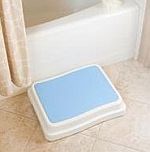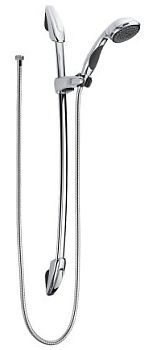A shower for the elderly should take into consideration any current disabilities and projected decline that may develop over the lifetime of the elderly person.
If you are aware of someone who is slowly losing their physical abilities and is noticeably on a decline, then chances are they will require changes to their current showering area. Adding extra support like shower grab bars and having a seating area for seniors can make all the difference. Removing the shower curb entryway can help those who have trouble stepping over high objects. Address these concerns before the unexpected happens.
Elderly Showers Guidelines
Building, replacing or modifying a preexisting shower stall will require a starting guideline. A good starting point is to consider the Americans with Disabilities Act (ADA) standards for accessible showers design. It includes such recommendations as shower seats needing to fill the full depth of the shower stall. Additionally, ADA guidelines for private homes states the shower chairs or seats should be 17 to 19 inches from the floor. Grab bars placed inside the showers should be between 33 to 36 inches off the floor.
 In a home environment, the federal standards can be used as a guideline for customization to fit the specific user. Federal standards are for public and commercial facilities and designed to fit average persons. When considering showers for the elderly, pay attention to the specifics of that person. They may be significantly smaller or larger than the expected averages so measurements need to be adjusted. Be sure the design fits for today and will accommodate future decline in abilities.
In a home environment, the federal standards can be used as a guideline for customization to fit the specific user. Federal standards are for public and commercial facilities and designed to fit average persons. When considering showers for the elderly, pay attention to the specifics of that person. They may be significantly smaller or larger than the expected averages so measurements need to be adjusted. Be sure the design fits for today and will accommodate future decline in abilities.
Removing the Shower Curbs
One of the most common issues for an elderly person who desires to use a shower is the step up into the shower stall or tub where the shower head is located. Most already have some sort of seat installed, but the steps or curb is the problem.
 Having some shower threshold steps for the elderly can help as the quickest and most affordable alternative. These steps can add an extra 4 inches of height and since the design is modular, you can keep adding an additional 2 inches to the top of the shower curb threshold step stool until it meets your desired needs.
Having some shower threshold steps for the elderly can help as the quickest and most affordable alternative. These steps can add an extra 4 inches of height and since the design is modular, you can keep adding an additional 2 inches to the top of the shower curb threshold step stool until it meets your desired needs.
 The newest tub designs for the elderly have a walk in tub design through a small door that opens on the side of a tub. The step is much smaller into this type of tub. A seat is provided to allow bathing or showering from a seated position. Once the door is closed it is a watertight seal that allows the tub to be filled or the shower to be used.
The newest tub designs for the elderly have a walk in tub design through a small door that opens on the side of a tub. The step is much smaller into this type of tub. A seat is provided to allow bathing or showering from a seated position. Once the door is closed it is a watertight seal that allows the tub to be filled or the shower to be used.
Another option is shower stalls that are even leveled with the floor surface. These types of handicap shower stalls have a very shallow basin to catch the shower water and are best suited for installation in a bathroom with a tiled floor in case a bit of water from the shower should creep out beyond the edge of the stall. This design uses a curtain instead of a door and can accommodate a rolling shower chair for those needing an assistant to help with the shower.
Remember that an floor level shower stall is not the only option to create showers for the elderly. Shower chairs, grab bars and shower heads for the elderly can be installed for improved convenience and support without any of the larger costs.
Washing Up In Bed
If you are someone or know of someone who is unable to get out of bed to clean up, consider “showering” in bed for the elderly. There are a few alternatives to clean those who are bedridden.
- For washing the hair, there are inflatable shower basins that can be placed under the head of an individual. Then you can pour water on the head without getting the bed wet.
- There are no rinse shampoos that do not require the use of water in order to wash the hair.
- There are also no rinse bathing wipes that can be disposed of after use.
